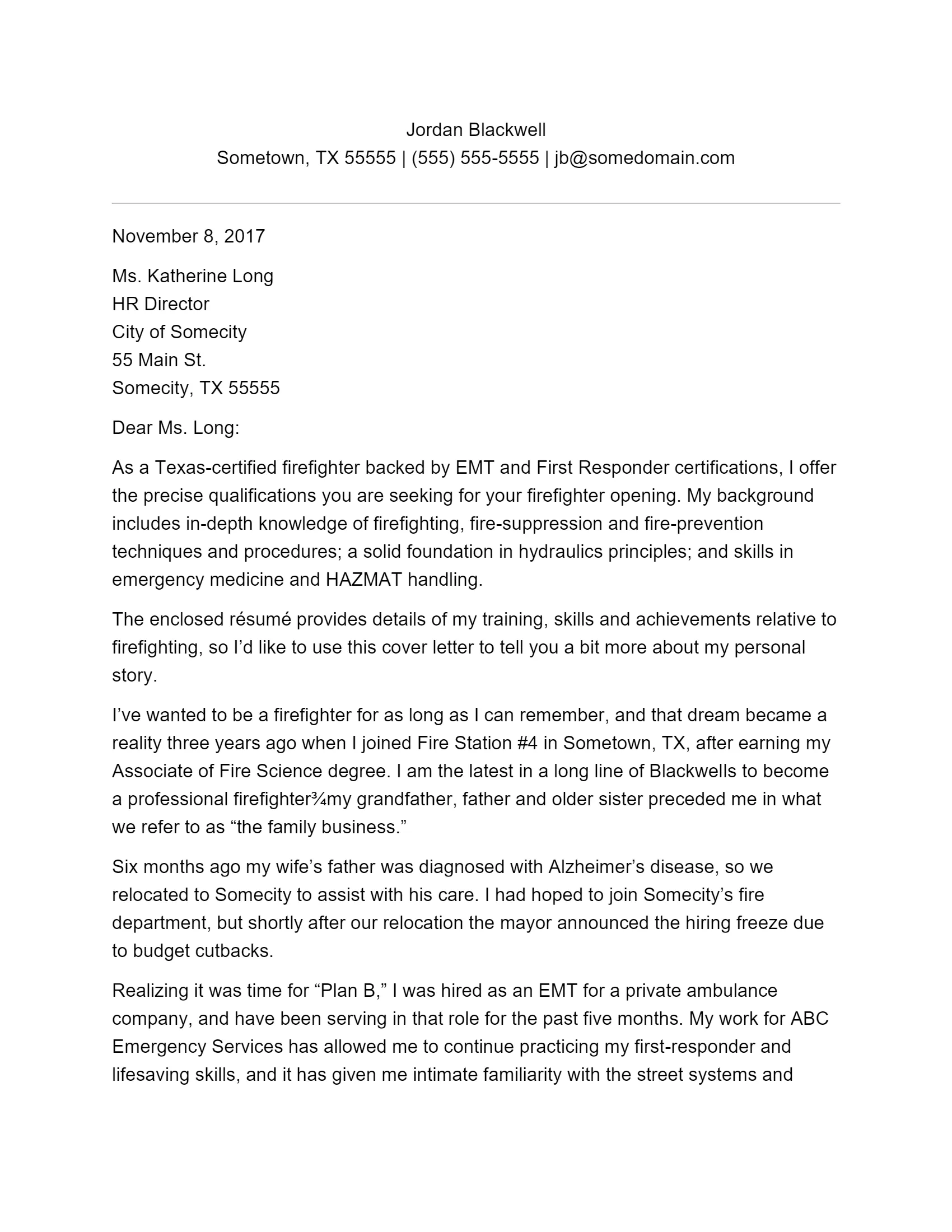What is a Firefighter Cover Letter?
A firefighter cover letter is a crucial document that accompanies your resume when applying for a firefighter position. It serves as your initial introduction to the hiring committee, providing an opportunity to showcase your qualifications, passion for the role, and suitability for the specific fire department. Unlike a resume, which presents a factual overview of your experience, a cover letter allows you to express your personality, elaborate on your skills, and demonstrate your genuine interest in becoming a firefighter. It’s your chance to make a strong first impression and set yourself apart from other applicants. A well-crafted cover letter can significantly increase your chances of landing an interview and ultimately, securing your dream job. A firefighter cover letter is your voice and personality for the job.
Key Components of a Firefighter Cover Letter
A compelling firefighter cover letter is composed of several essential elements that work together to create a persuasive argument for your candidacy. Each section serves a specific purpose, contributing to the overall effectiveness of your application. By carefully constructing each component, you can effectively communicate your qualifications and increase your chances of getting an interview. The key components include a header, a personalized greeting, an introductory paragraph expressing your interest, body paragraphs highlighting your skills and experience, a paragraph detailing your achievements, a closing paragraph with a call to action, and a professional closing. Remember to maintain a professional tone, proofread carefully, and tailor your letter to each specific fire department to maximize your impact. You will need a header, greeting, introduction, body paragraphs, and a conclusion.
Header and Contact Information
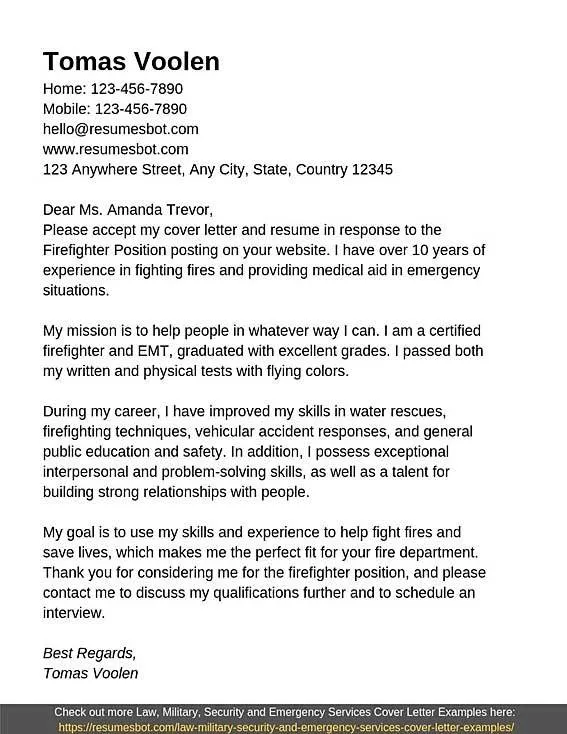
Your header should include your full name, address, phone number, and email address. This information should be clearly visible and at the top of the document. Ensure your contact information is up-to-date and professional. For the fire department, include the date of application, the name of the hiring manager (if known), and the fire department’s address. Make sure the heading looks professional, use a simple font. The header is the first thing the hiring manager will see, so make a good first impression.
Personalized Greeting
Always address your cover letter to a specific person whenever possible. Research the fire department to find the hiring manager’s name. A personalized greeting, such as “Dear Mr. Smith,” demonstrates that you’ve taken the time to research the department and are genuinely interested in the position. Avoid generic greetings like “To Whom It May Concern.” If you are unable to find a specific name, use a professional greeting such as “Dear Hiring Committee.” Personalizing your greeting makes your cover letter stand out and shows that you care enough to research.
Body Paragraph 1: Expressing Interest and Passion
In the first paragraph, clearly state the position you are applying for and where you saw the job posting. Express your enthusiasm for the role and the fire department. Briefly explain why you are interested in becoming a firefighter and what motivates you. Mention any personal connections to the fire service, such as family members or experiences that have inspired you. Show genuine passion for the fire service and a strong desire to serve your community. Be clear on the position you are applying for and the fire department.
Body Paragraph 2: Highlighting Relevant Skills and Experience
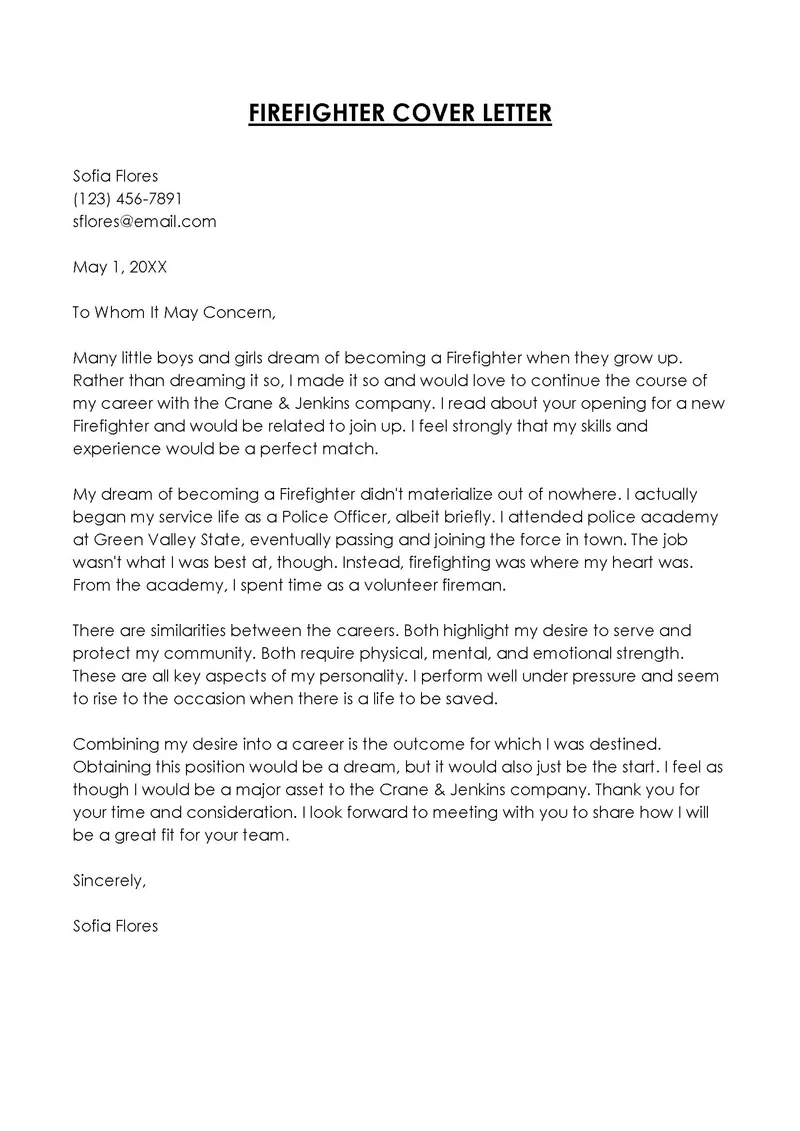
This is the core of your cover letter. Highlight the skills and experience that make you a strong candidate for the firefighter position. Use specific examples to illustrate your abilities. Connect your qualifications to the requirements of the job description. Provide evidence of your skills, such as your experience working as a team. Break down the skills into sub-sections to make it easier for the hiring manager. Be sure to include certifications and training, emergency response skills, teamwork, and physical fitness.
Emergency Response Skills
Detail your experience and skills related to emergency response. This includes experience in handling emergency situations, medical knowledge, and any certifications in first aid, CPR, or EMT. Describe your experience in responding to incidents, providing assistance, and ensuring scene safety. Give examples of how you have used your skills to respond to emergencies and protect lives. Show your competence in the field.
Teamwork and Communication
Firefighting is a team-based profession. Highlight your ability to work effectively as part of a team, your communication skills, and your ability to follow instructions. Mention any experience you have in leading or participating in team activities. Provide examples of how you have successfully communicated with team members, supervisors, and the public. Show you’re a team player.
Physical Fitness and Stamina
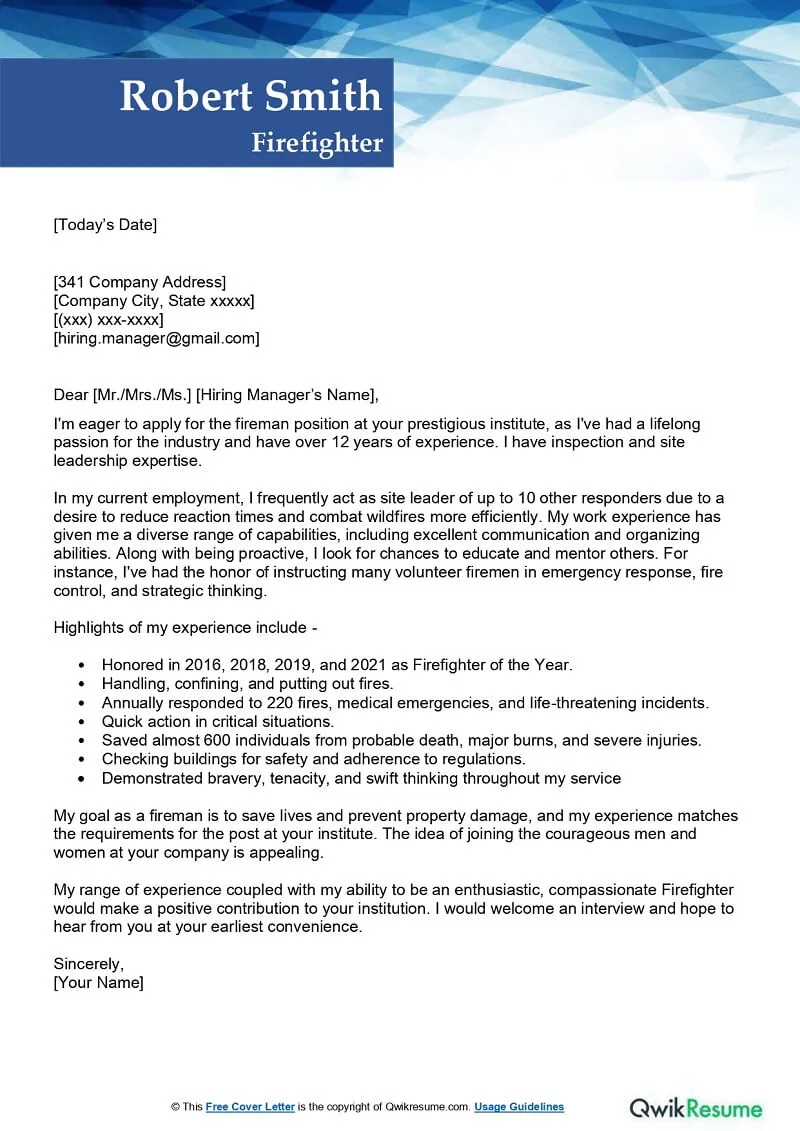
Firefighting is physically demanding. Demonstrate your commitment to physical fitness and your ability to perform under pressure. Mention any physical fitness activities you participate in, such as running, weight training, or sports. If you have completed any physical fitness tests, list them. State that you are willing to train to remain in top physical condition for the job.
Certifications and Training
List all relevant certifications and training you have completed. This includes certifications such as EMT, CPR, hazardous materials training, and fire science courses. Mention any specialized training that is related to firefighting or emergency services. Provide the dates and institutions where you received your certifications and training. Make sure the certifications and training meet the qualifications of the department. A lack of certifications can disqualify you.
Body Paragraph 3: Showcasing Achievements and Quantifiable Results
Use this paragraph to showcase your achievements and quantify your results. If possible, provide specific examples of your accomplishments and the impact you made in previous roles or experiences. Use numbers and data to demonstrate your skills and abilities. For example, you can describe how you improved response times, reduced errors, or increased efficiency in a previous role. Achievements make you stand out.
Closing Paragraph and Call to Action
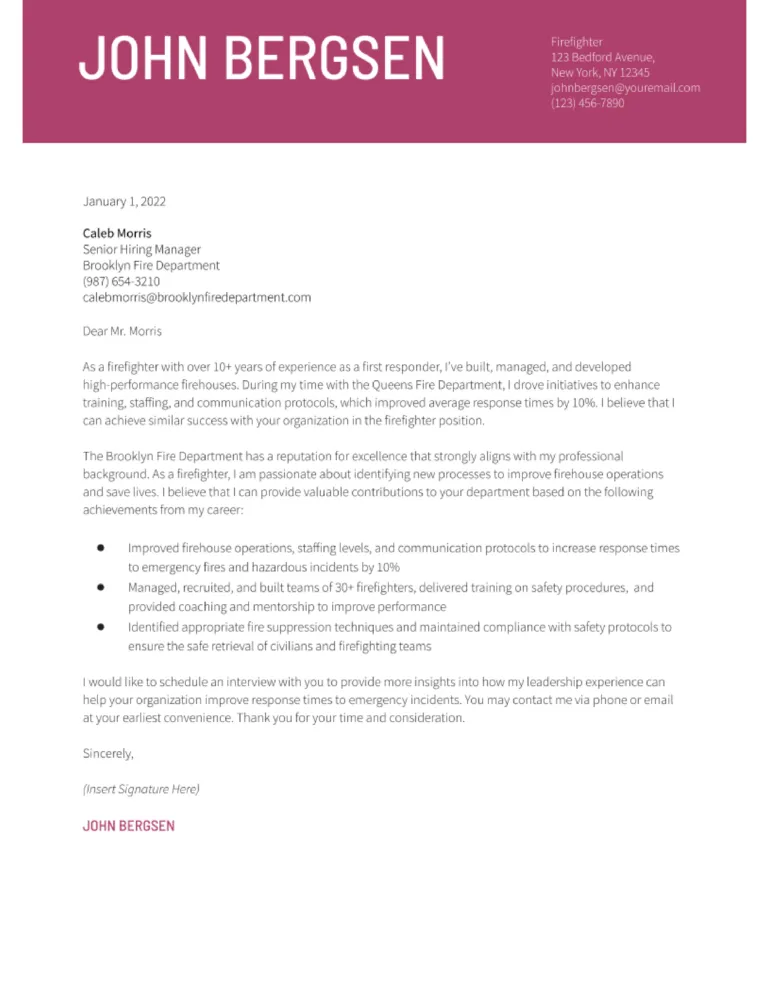
In the closing paragraph, reiterate your interest in the position and thank the hiring manager for their time and consideration. Express your eagerness to learn more about the opportunity and discuss your qualifications in person. Include a clear call to action, such as stating that you are available for an interview and can be reached at your phone number or email address. End your letter with a professional closing, such as “Sincerely” or “Respectfully.”
Formatting and Design Tips
A well-formatted cover letter is easy to read and visually appealing. Use a professional font such as Arial, Times New Roman, or Calibri. Maintain a consistent font size (11 or 12 points) throughout the document. Use single-space paragraphs with a space between each paragraph. Keep the letter concise, ideally within one page. Use bullet points or numbered lists to highlight key information. Proofread carefully for any errors in grammar or spelling before submitting your application. Consider these points while formatting your letter. The formatting makes a big difference in how your letter is perceived.
Proofreading and Editing
Before submitting your cover letter, proofread it meticulously for any errors in grammar, spelling, and punctuation. Errors can create a negative impression and undermine your credibility. Read the letter aloud to catch any awkward phrasing or inconsistencies. Ask a friend, family member, or career advisor to review your cover letter for feedback. Ensure your cover letter is free of errors and reflects your professionalism. Proofreading is extremely important for the job.
Common Mistakes to Avoid
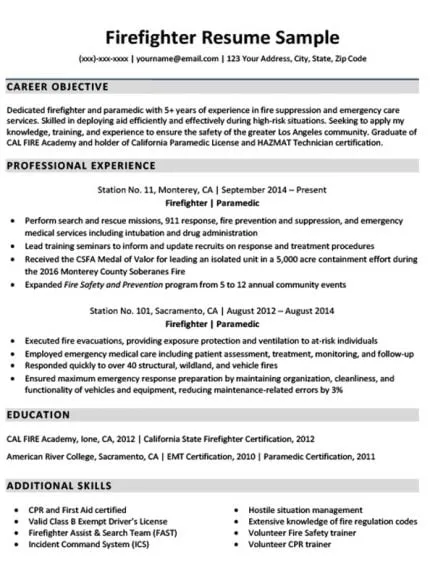
Avoid common mistakes that can hurt your chances of getting hired. Do not submit a generic cover letter; tailor it to each fire department you are applying to. Avoid typos, grammatical errors, and informal language. Do not include irrelevant information. Do not focus solely on what you want; demonstrate how you can benefit the fire department. Avoid being overly enthusiastic or exaggerating your qualifications. These mistakes can prevent your cover letter from getting you the job.
Tailoring Your Cover Letter
Tailoring your cover letter is crucial for demonstrating your interest in the specific fire department and the position. Research the fire department’s mission, values, and recent activities. Customize your cover letter to reflect your understanding of the department and its needs. Highlight the skills and experience that align with the specific requirements of the job posting. Show how your qualifications and goals match the values of the fire department. Ensure that your cover letter is relevant to the department.
Researching the Fire Department
Conduct thorough research on the fire department you are applying to. Visit the department’s website to learn about their mission, values, and recent activities. Read news articles or social media posts to stay informed. Tailor your cover letter to demonstrate your understanding of the department and its needs. Knowing about the department shows you care.
Using Keywords Effectively
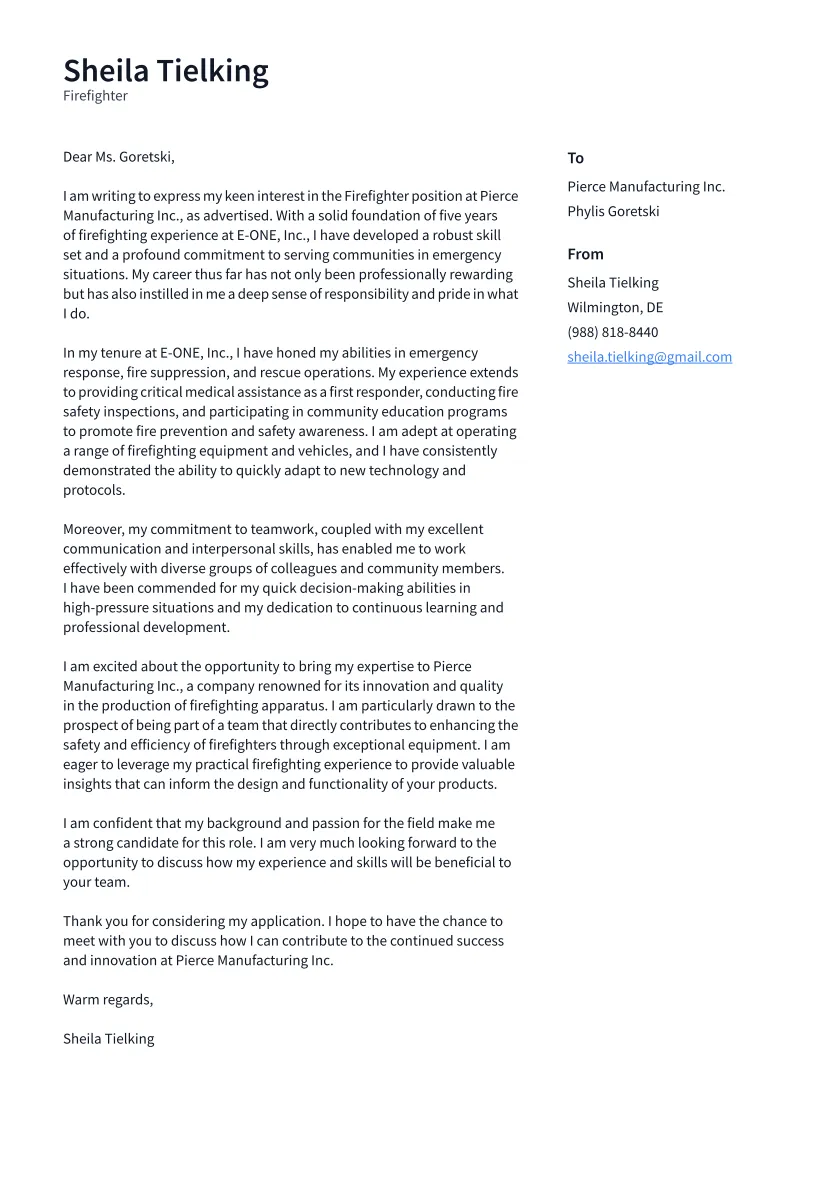
Use keywords from the job description throughout your cover letter. Identify the key skills, qualifications, and requirements mentioned in the job posting. Incorporate these keywords naturally into your cover letter to demonstrate your alignment with the position. Use these keywords in the right context, don’t overstuff them. Use the keywords to show the hiring manager you’re the right fit.
Example Cover Letter
Use the following example as a template for your firefighter cover letter:
[Your Name] [Your Address] [Your Phone Number] [Your Email Address]
[Date]
[Hiring Manager Name (if known), or Hiring Committee] [Fire Department Name] [Fire Department Address]
Dear [Mr./Ms./Mx. Last Name or Hiring Committee],
I am writing to express my enthusiastic interest in the Firefighter position at [Fire Department Name], as advertised on [Platform where you saw the ad]. As a highly motivated and dedicated individual with a strong passion for serving my community, I am eager to contribute my skills and experience to your esteemed department.
[Body Paragraphs, see above]
Thank you for considering my application. I am eager to learn more about the opportunity and discuss my qualifications in person. I am available for an interview at your earliest convenience. You can reach me at [Your Phone Number] or [Your Email Address].
Sincerely, [Your Signature] [Your Typed Name]
This template gives you the basic outline.
Summary
A well-crafted firefighter cover letter is your opportunity to showcase your qualifications, passion, and suitability for the role. By following the guidelines and tips in this guide, you can create a compelling cover letter that will impress the hiring committee and increase your chances of getting hired. Remember to tailor your letter, highlight your skills, and express your genuine interest. Good luck with your application and your future career as a firefighter! Always tailor your cover letter and keep it up to date. Be sure your cover letter is professional and represents you well.
